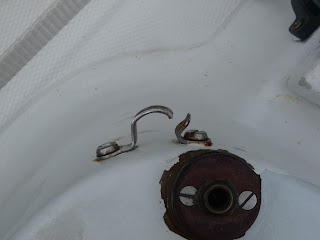 |
| Santa Cruz de La Palma |
We spent 10 days in La Palma and probably didn't do it full justice as we were recovering from the passage down (mentally more than physically really). Even so, we had a good time and found the island very pleasant, with varied scenery and excellent fresh produce.
 |
| To the north: a dry river gorge, with plenty of bananas growing. |
 |
| In the midst of high laurel forest. |
 |
| To the south: scene of the most recent volcanic activity (70s). |
 |
| Black sand and igneous rock abutting blue sea and sky. |
Although the marina was about half empty there was no shortage of fellow cruisers for us to hang out with. It was a particular pleasure to meet Pippa and Dee on
Sula - our kind of boat: Elizabethan 31, 1967 vintage. They proved to be great partners in foraging and we enjoyed a couple of chestnut feasts together. Our other great foraging success was finding a big patch of ripe cherry tomatoes growing wild by the roadside. Delicious!
We departed SC de LP on the Monday evening so that we could be confident of reaching Las Palmas de Gran Canaria in daylight, on Wednesday morning. The passage was fairly uneventful and mostly pleasant. We skirted round the dreaded acceleration zones (where the wind funnels around and between the high islands and can suddenly boost its speed by 15 knots) and didn't have to motor much.
Originally we planned to wait until after the ARC (Atlantic Rally for Cruisers) had left Las Palmas but Raymarine tech support (whom we contacted about the problem with our wind instrument) directed us there to meet up with their factory engineer in town just for the big event.
Many times we'd been told that Las Palmas is a mad place to be in the run-up to the ARC. Over 200, mostly large and very expensive, boats fill the marina to capacity and the overspill fills the anchorage area as well. We were a bit nervous about even finding a spot to drop the hook but all proved to be well on arrival when we found a
Fettler-sized gap tucked well in to the anchorage.
 |
| Marina? Full. |
 |
No expense spared. A helicopter rescue
demonstration for the ARC. |
 |
| Things were snug in the anchorage. |
Las Palmas has been altogether a pleasant surprise. We had good luck with getting things sorted right from the start, when we randomly encountered the very Raymarine engineer we needed to see. Within hours of arrival the TackTick trouble was over.
The social scene is brilliant too and we're really enjoying catching up with old friends and meeting new. Las Palmas is a big city and looks possibly a bit grim on the approach but it's very friendly and a half-hour walk takes one into the charming old town. There's even a free city bike scheme which we have been able to register for.
The ARC departed yesterday, amidst great fanfare. We walked along the sea wall to see them off and returned to a much more tranquil marina and anchorage.
 |
| And they're off! |
 |
| Bow fenders are compulsory at the start. |
 |
| Next stop: St. Lucia. Bon voyage! |




















